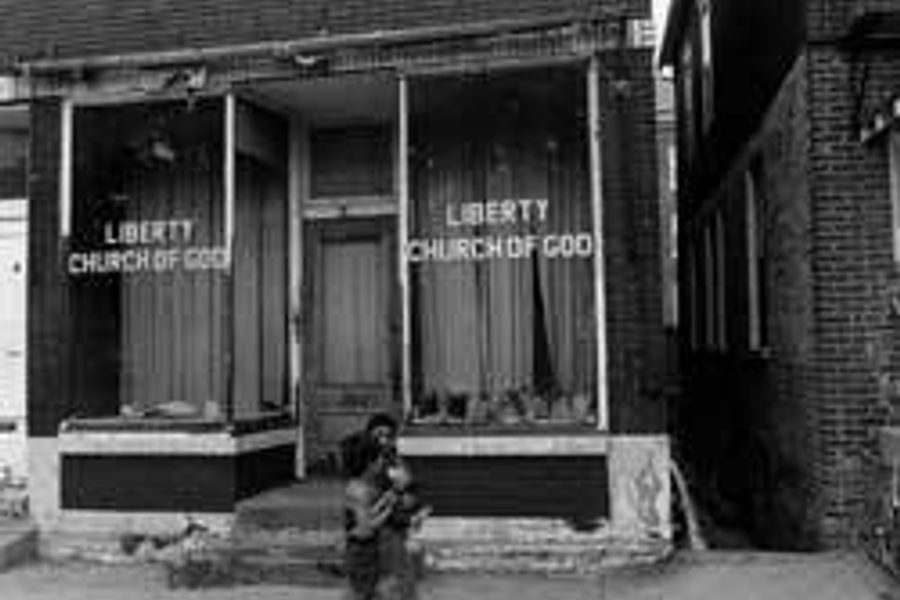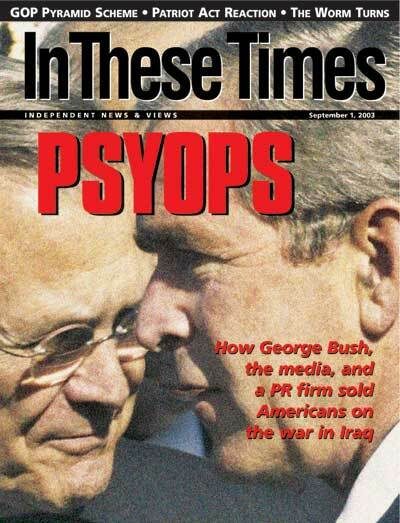
Chicago brags it’s “a city of neighborhoods.” So does Philadelphia. So do Baltimore, Boston, and San Francisco, among many others. But the next time you’re tempted to regard this as a point of municipal pride, consider the argument at the heart of Omar M. McRoberts’ new book Streets of Glory, a study of African-American churches in the impoverished Four Corners section of Boston. While assessing the role of these churches in urban life, McRoberts drops in the following observation almost by the way:
McRoberts, an assistant professor of sociology at the University of Chicago, shows how this dilemma underlies the familiar urban phenomenon he describes: that of the poor black neighborhood bursting with churches. While addressing the implications of such religious clusters for a pet social policy of the Republican party, so-called Charitable Choice, he is compelled to return again and again to the pernicious consequences of a concept so innocuous we associate it with Mr. Rogers.
Charitable Choice, also called the faith-based initiative, is a doctrine postulating that atheists controlling the federal government now prevent churches from providing social services that would not merely ameliorate poverty but transform lives. If “faith institutions” were liberated, the argument goes, neighborhoods with so many churches would surely have ample social services, and thrive. But McRoberts’ research suggests the contrary and, along the way, offers a glimpse of the role neighborhood-based politics plays in perpetuating the segregation and continued impoverishment of black people.
Religious districts like Four Corners, McRoberts demonstrates, are not parishes with too many pews; they are the religious equivalent of manufacturing zones, specialized areas serving African Americans from throughout the metropolitan area. The churches within them represent and foster community, but not in the localized way that the word is used by people giving out Community Development Block Grants. Few of these commuter churches are willing, much less able, to provide social services where they’re located, and those that do may be threatened by neighborhood improvement. Most don’t own their own buildings. Rental churches can run soup kitchens and drop-in centers if they choose, but to become community leaders in redevelopment efforts would jeopardize their own ability to stay put. Churches do engage with “the street,” but in limited ways and for their own institutional purposes.
————–
If you happen to live in a manufacturing district, the good wages paid to commuting factory workers don’t compensate for the smoke and noise of factories. And if you happen to live in a religious district like Four Corners, the churches’ service to a wider community doesn’t make up for their being in the way of redevelopment. And here the latent definition of neighborhood as “unified entity to compete for scarce resources” shows up again; because in a religious district, the very factors requiring an infusion of community development money—low property values and the churches drawn to them—are the ones that will prevent its arrival. As McRoberts summarizes:
In addition, the churches are as liable to move as the people, a phenomenon McRoberts dubs “bouncing”: “As they bounce from neighborhood to neighborhood, they gather new members, becoming increasingly metropolitan in scope, and abandon parishlike attachment to particular neighborhoods.” If individual transience is considered an obstacle to social cohesion, McRoberts asks, how much more an obstacle is the here-today, gone-tomorrow condition of one of society’s strongest institutions?
McRoberts also examines how the religious doctrine of exile, a life “in the world but not of the world,” emerges from a broader black experience of exile: Southerners in the North, island people on the mainland, Africans in America. Thus many churches hold themselves apart from the neighborhoods others imagine they should serve. “Four Corners churches conceived of the street in three ways: as an evil other to be avoided at all cost, as a recruitment ground … and as a point of contact with persons at risk who are to be served,” McRoberts observes. Out of 21 congregations only one is committed to on-site social service without proselytizing, and two to services that include proselytizing. So much for the Charitable Choice notion that churches are yearning to take care of poor people without trying to convert them.
Yet McRoberts is polite about studies showing that two-thirds of black churches are willing to provide social services, and about speculation that African-Americans have a higher tolerance than whites for breaching the barrier between church and state. “I doubt neither the figures nor the explanation. I do wonder, however, about the hefty minority … that say they would refuse to accept government funds.” He lets one of the Four Corners ministers speak for many of those in opposition: “‘We should try to get away from the secular world’s money. Because they want to come control what you do. The feds are trying to control the churches.’”
————–
The author’s ideas deserve better expression than he gives them. Though his narrative skills are strong, McRoberts is liable to sentences like, “The term ‘frame’ refers to ‘schemata of interpretation’ that enable individuals to ‘locate, perceive, identify, and label’ occurrences within their life space and the world at large.” Academic jargon of this density puts off the lay reader. Just one more edit would probably have sufficed to complete the transformation of Streets of Glory from a monograph to a book. Still, the professor’s scholarly insight outweighs his occasionally laborious writing.
McRoberts has performed a great service by providing evidence to rebut those who imagine the profusion of churches in poor black neighborhoods represents some sort of pathological African-American preference for consolation over self-improvement. And he’s demonstrated that, at least in the black community, there’s less to Charitable Choice than its proponents claim.
But the idea that stands out is that the very notion of “neighborhood” interferes with redevelopment in neighborhoods needing it the most. Those who squirm at cities’ delight in designating sections “Bronzeville” or “Chinatown” should look to McRoberts’ analysis for the source of their queasiness: The celebrated “neighborhood” is more or less a device for keeping people in their place, their resources at a fixed level. Non-squirmers should try to imagine a neighborhood called Jewtown. Jesse Jackson did, and was pilloried for it. Maybe he was being an anti-Semite. Maybe he was just being a good city-of-neighborhoods Chicagoan.
Four Corners was a casualty of a fundamentally competitive and often adversarial urban political and economic process. … The politics of land use, economic development, municipal services, education, and housing in Boston have often revolved around neighborhoods and their respective ability to either compete for limited resources or to defend territorial integrity. … Meanwhile, Boston mayoral politics frequently appeal to the neighborhood basis of resource allocation. Raymond Flynn, mayor of Boston from 1983 to 1993, went as far as to refer to himself as “the neighborhood mayor.”If, as applied here, the very concept of “neighborhood” is a political strategy to divide, conquer, and make sure “them that has gets,” no wonder urban powers-that-be are so partial to it. Competition among communities for scarce resources can spark creation of powerful grassroots movements, Saul Alinsky-style, but it’s important to recognize that the system makes the neediest locations the ones least likely to succeed in snagging the federal, state, local, and philanthropic dollars designed to help people just like them.
McRoberts, an assistant professor of sociology at the University of Chicago, shows how this dilemma underlies the familiar urban phenomenon he describes: that of the poor black neighborhood bursting with churches. While addressing the implications of such religious clusters for a pet social policy of the Republican party, so-called Charitable Choice, he is compelled to return again and again to the pernicious consequences of a concept so innocuous we associate it with Mr. Rogers.
Charitable Choice, also called the faith-based initiative, is a doctrine postulating that atheists controlling the federal government now prevent churches from providing social services that would not merely ameliorate poverty but transform lives. If “faith institutions” were liberated, the argument goes, neighborhoods with so many churches would surely have ample social services, and thrive. But McRoberts’ research suggests the contrary and, along the way, offers a glimpse of the role neighborhood-based politics plays in perpetuating the segregation and continued impoverishment of black people.
Religious districts like Four Corners, McRoberts demonstrates, are not parishes with too many pews; they are the religious equivalent of manufacturing zones, specialized areas serving African Americans from throughout the metropolitan area. The churches within them represent and foster community, but not in the localized way that the word is used by people giving out Community Development Block Grants. Few of these commuter churches are willing, much less able, to provide social services where they’re located, and those that do may be threatened by neighborhood improvement. Most don’t own their own buildings. Rental churches can run soup kitchens and drop-in centers if they choose, but to become community leaders in redevelopment efforts would jeopardize their own ability to stay put. Churches do engage with “the street,” but in limited ways and for their own institutional purposes.
————–
If you happen to live in a manufacturing district, the good wages paid to commuting factory workers don’t compensate for the smoke and noise of factories. And if you happen to live in a religious district like Four Corners, the churches’ service to a wider community doesn’t make up for their being in the way of redevelopment. And here the latent definition of neighborhood as “unified entity to compete for scarce resources” shows up again; because in a religious district, the very factors requiring an infusion of community development money—low property values and the churches drawn to them—are the ones that will prevent its arrival. As McRoberts summarizes:
The absence of secular neighborhood-oriented institutions placed the onus on churches to “make noise” on behalf of the neighborhood and develop the kind of interpersonal and interinstitutional networks that have supported mobilization in other locales. But these churches drew few of their members from the neighborhood.And, he continues:
The idea of forging unity in the neighborhood was … doubly daunting, for not only were institutions diversely constituted, but many did not even acknowledge the existence of the locale. The rare institutions that did claim the locale differed in their approaches to neighborhood problems and fell into conflict.Arguing that so-called storefront churches are the consequence rather than the cause of decline in urban neighborhoods, McRoberts describes how in the wake of economic deterioration, “The original religious ecology of four quaint neighborhood congregations gave way to a religious district in which dozens of churches coexisted by not competing for the same local membership pool.” But he notes that cheap space is not the only reason black churches cluster together, tracing the pattern back to the days of segregation. Though confined to a single neighborhood, African-Americans maintained class distinctions. But each caste, and each denomination associated with it, had no choice but to set up shop in roughly the same place, creating a system of church membership having virtually nothing to do with geography. Even when African-Americans gained a measure of geographic mobility, relative independence between location and church affiliation remained; the commutes are just longer.
In addition, the churches are as liable to move as the people, a phenomenon McRoberts dubs “bouncing”: “As they bounce from neighborhood to neighborhood, they gather new members, becoming increasingly metropolitan in scope, and abandon parishlike attachment to particular neighborhoods.” If individual transience is considered an obstacle to social cohesion, McRoberts asks, how much more an obstacle is the here-today, gone-tomorrow condition of one of society’s strongest institutions?
McRoberts also examines how the religious doctrine of exile, a life “in the world but not of the world,” emerges from a broader black experience of exile: Southerners in the North, island people on the mainland, Africans in America. Thus many churches hold themselves apart from the neighborhoods others imagine they should serve. “Four Corners churches conceived of the street in three ways: as an evil other to be avoided at all cost, as a recruitment ground … and as a point of contact with persons at risk who are to be served,” McRoberts observes. Out of 21 congregations only one is committed to on-site social service without proselytizing, and two to services that include proselytizing. So much for the Charitable Choice notion that churches are yearning to take care of poor people without trying to convert them.
Yet McRoberts is polite about studies showing that two-thirds of black churches are willing to provide social services, and about speculation that African-Americans have a higher tolerance than whites for breaching the barrier between church and state. “I doubt neither the figures nor the explanation. I do wonder, however, about the hefty minority … that say they would refuse to accept government funds.” He lets one of the Four Corners ministers speak for many of those in opposition: “‘We should try to get away from the secular world’s money. Because they want to come control what you do. The feds are trying to control the churches.’”
————–
The author’s ideas deserve better expression than he gives them. Though his narrative skills are strong, McRoberts is liable to sentences like, “The term ‘frame’ refers to ‘schemata of interpretation’ that enable individuals to ‘locate, perceive, identify, and label’ occurrences within their life space and the world at large.” Academic jargon of this density puts off the lay reader. Just one more edit would probably have sufficed to complete the transformation of Streets of Glory from a monograph to a book. Still, the professor’s scholarly insight outweighs his occasionally laborious writing.
McRoberts has performed a great service by providing evidence to rebut those who imagine the profusion of churches in poor black neighborhoods represents some sort of pathological African-American preference for consolation over self-improvement. And he’s demonstrated that, at least in the black community, there’s less to Charitable Choice than its proponents claim.
But the idea that stands out is that the very notion of “neighborhood” interferes with redevelopment in neighborhoods needing it the most. Those who squirm at cities’ delight in designating sections “Bronzeville” or “Chinatown” should look to McRoberts’ analysis for the source of their queasiness: The celebrated “neighborhood” is more or less a device for keeping people in their place, their resources at a fixed level. Non-squirmers should try to imagine a neighborhood called Jewtown. Jesse Jackson did, and was pilloried for it. Maybe he was being an anti-Semite. Maybe he was just being a good city-of-neighborhoods Chicagoan.
Kelly Kleiman’s reportage and criticism appear regularly in The Chicago Reader, the Chicago Tribune, Chicago Magazine and the Wall Street Journal.






